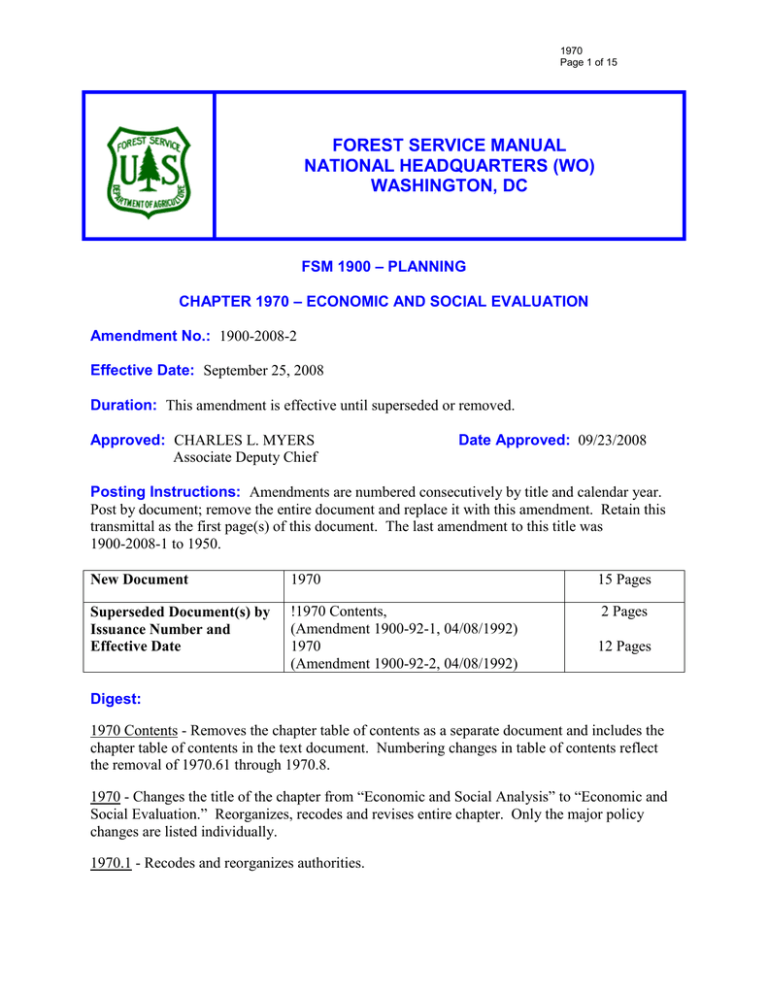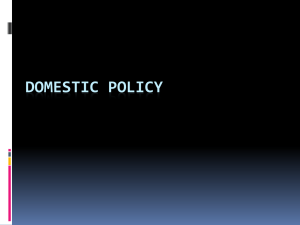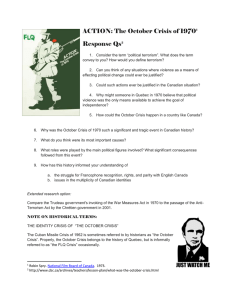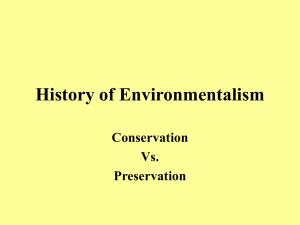FOREST SERVICE MANUAL NATIONAL HEADQUARTERS (WO) WASHINGTON, DC
advertisement

1970 Page 1 of 15 FOREST SERVICE MANUAL NATIONAL HEADQUARTERS (WO) WASHINGTON, DC FSM 1900 – PLANNING CHAPTER 1970 – ECONOMIC AND SOCIAL EVALUATION Amendment No.: 1900-2008-2 Effective Date: September 25, 2008 Duration: This amendment is effective until superseded or removed. Approved: CHARLES L. MYERS Associate Deputy Chief Date Approved: 09/23/2008 Posting Instructions: Amendments are numbered consecutively by title and calendar year. Post by document; remove the entire document and replace it with this amendment. Retain this transmittal as the first page(s) of this document. The last amendment to this title was 1900-2008-1 to 1950. New Document 1970 15 Pages Superseded Document(s) by Issuance Number and Effective Date !1970 Contents, (Amendment 1900-92-1, 04/08/1992) 1970 (Amendment 1900-92-2, 04/08/1992) 2 Pages 12 Pages Digest: 1970 Contents - Removes the chapter table of contents as a separate document and includes the chapter table of contents in the text document. Numbering changes in table of contents reflect the removal of 1970.61 through 1970.8. 1970 - Changes the title of the chapter from “Economic and Social Analysis” to “Economic and Social Evaluation.” Reorganizes, recodes and revises entire chapter. Only the major policy changes are listed individually. 1970.1 - Recodes and reorganizes authorities. WO AMENDMENT 1900-2008-2 EFFECTIVE DATE: 09/25/2008 DURATION: This amendment is effective until superseded or removed. 1970 Page 2 of 15 FSM 1900 – PLANNING CHAPTER 1970 – ECONOMIC AND SOCIAL EVALUATION Digest--Continued: 1970.11 - Establishes new code and caption for statutory authorities for economic and social evaluations. 1970.12 - Establishes new code and caption for regulations and Executive orders and adds additional authorities. 1970.2 - Revises objectives for economic and social evaluations. 1970.3 - Revises policy. 1970.41 - Revises caption from the obsolete “Deputy Chief, Programs and Legislation” to “Chief” and identifies the Chief as having program decision authority for economic and social evaluations. 1970.42 - Revises caption from “Regional Foresters” to “Washington Office, Director, Ecosystem Management Coordination” and sets forth responsibilities. 1970.43 - Revises caption from “Station Directors” to “Regional Foresters.” 1970.44 - Changes caption from “Area Director” to “Forest Supervisor.” 1970.45 - Changes caption from “Forest Supervisors” to “Line Officers and Decision Makers.” 1970.6 - Revises direction for scope of analyses, removes codes and captions for 1970.61 through 1970.63. 1970.7 - Removes code and caption. 1970.8 - Removes code and caption. 1971 - Changes caption from “Evaluating Economic Efficiency” to “Economic Evaluations” and revises policy. 1971.02 - Revises objectives for economic evaluations. 1971.1 - Changes caption from “Tasks in Evaluating Economic Efficiency” to “Scope” and sets forth direction. 1971.2 - Revises Measures of Economic Efficiency. 1971.21 - Removes code and caption. 1971.3 - Revises caption from” Identifying Inputs, Outputs and Production Process” to “Discount Rates” and sets forth direction. WO AMENDMENT 1900-2008-2 EFFECTIVE DATE: 09/25/2008 DURATION: This amendment is effective until superseded or removed. 1970 Page 3 of 15 FSM 1900 – PLANNING CHAPTER 1970 – ECONOMIC AND SOCIAL EVALUATION Digest--Continued: 1971.4 - Revises caption from “Analyzing Costs” to “Costs Considered” and revises direction. Removes code and captions from 1971.41 through 1971.42. 1971.5 - Revises caption from “Use of Economic Values” to “Benefits Considered” and revises direction. 1971.6 - Removes code and caption. 1972 - Changes caption from “Economic Impact Analysis” to “Economic Impact Evaluation.” 1972.02 - Revises objectives for economic impact evaluations. 1972.1 - Changes caption from “Measures of Economic Impact” to “Scope.” Sets forth direction. 1972.2 - Establishes new code, caption, and sets forth direction for “Measures of Economic Impact.” 1973 - Changes caption from “Social Impact Analysis” to “Social Analysis.” 1973.02 - Revises objectives for social analysis. 1973.03 - Revises policy for social analysis. 1973.1 - Changes caption from “Tasks in Social Impact Analysis” to “Scope” and sets forth direction. 1973.2 - Changes caption from “Selection of Variables” to “Methods” and revises direction. WO AMENDMENT 1900-2008-2 EFFECTIVE DATE: 09/25/2008 DURATION: This amendment is effective until superseded or removed. 1970 Page 4 of 15 FSM 1900 – PLANNING CHAPTER 1970 – ECONOMIC AND SOCIAL EVALUATION Table of Contents 1970.1 - Authority....................................................................................................................... 5 1970.11 - Statutory Authorities............................................................................................... 5 1970.12 - Regulations and Executive Orders.......................................................................... 5 1970.2 - Objectives ..................................................................................................................... 6 1970.3 - Policy ............................................................................................................................ 6 1970.4 - Responsibility ............................................................................................................... 7 1970.41 - Chief ....................................................................................................................... 7 1970.42 - Washington Office, Director, Ecosystem Management Coordination ................... 7 1970.43 - Regional Foresters .................................................................................................. 7 1970.44 - Forest Supervisors .................................................................................................. 8 1970.45 - Line Officers and Decision Makers ........................................................................ 8 1970.5 - Definitions .................................................................................................................... 8 1970.6 - Scope of Analyses ........................................................................................................ 8 1971 - ECONOMIC EVALUATIONS ............................................................................... 9 1971.02 - Objectives ............................................................................................................... 9 1971.1 - Scope ............................................................................................................................ 9 1971.2 - Measures of Efficiency ............................................................................................... 10 1971.3 - Discount Rates ............................................................................................................ 10 1971.4 - Costs Considered ........................................................................................................ 10 1971.5 - Benefits Considered.................................................................................................... 10 1972 - ECONOMIC IMPACT EVALUATION ................................................................ 11 1972.02 - Objectives ............................................................................................................. 11 1972.1 - Scope .......................................................................................................................... 12 1972.2 - Measures of Economic Impact ................................................................................... 12 1973 - SOCIAL ANALYSIS .......................................................................................... 12 1973.02 - Objectives ............................................................................................................. 12 1973.03 - Policy .................................................................................................................... 13 1973.1 - Scope .......................................................................................................................... 13 1973.2 - Methods ...................................................................................................................... 13 WO AMENDMENT 1900-2008-2 EFFECTIVE DATE: 09/25/2008 DURATION: This amendment is effective until superseded or removed. 1970 Page 5 of 15 FSM 1900 – PLANNING CHAPTER 1970 – ECONOMIC AND SOCIAL EVALUATION This chapter provides policy and principles for conducting economic and social evaluation of programs, resource plans, and projects in the Forest Service. 1970.1 - Authority The following statutes and Agency policies identify the general requirements or support for the application of economic and social evaluation in support of Forest Service planning and decisionmaking. 1970.11 - Statutory Authorities 1. Multiple-Use Sustained-Yield Act of 1960. (74 Stat. 215; 16 U.S.C. 528-531). This act sets forth guiding principles for managing the resources of the National Forest System. The direction to manage these resources for the greatest good over time necessitates the use of economic and social analysis in determining management of the National Forest System. 2. National Environmental Policy Act of 1969. (83 Stat. 852; 42 U.S.C. 4321, 43314335, 4341-4347). This act requires the use of natural and social sciences in planning and decisionmaking to fulfill the social, economic, and other requirements of present and future generations of Americans. 3. Forest and Rangeland Renewable Resources Planning Act of 1974, as amended by the National Forest Management Act of 1976. (88 Stat. 476; 16 U.S.C. 1600-1614) as amended by the National Forest Management Act of 1976 (90 Stat. 2949). These acts establish the requirement to use economic and other sciences in the land management planning process and in the development of the Resources Program and Assessment. 4. Public Rangelands Improvement Act of 1978 (43 U.S.C. 1901). This act requires economic analysis of grazing use on Forest Service administered lands, fee formulas, and funding of rangeland programs and identification of associated economic impacts on the livestock industry. 1970.12 - Regulations and Executive Orders Aside from statutes, authorities for Forest Service economic and social evaluations derive from Executive Orders and the Code of Federal Regulations. The following are relevant to economic and social analysis: 1. Executive Order 12866, as amended by Executive Order 13258 and Executive Order 13422 on “Regulatory Planning and Review.” The order requires Federal agencies to assess both cost and benefits (quantitative and qualitative) of an intended regulation and propose or adopt a regulation. WO AMENDMENT 1900-2008-2 EFFECTIVE DATE: 09/25/2008 DURATION: This amendment is effective until superseded or removed. 1970 Page 6 of 15 FSM 1900 – PLANNING CHAPTER 1970 – ECONOMIC AND SOCIAL EVALUATION 2. Office of Management and Budget Circular A-4 Regulatory Analysis (Issued September 17, 2003). This circular provides the OMB’s guidance to Federal agencies on the development of regulatory analysis as required under Section 6(a)(3)(c) of Executive Order 12866. 3. Office of Management and Budget Circular A-94 “ Guidelines and Discount Rates for Benefit-Cost analysis of Federal Programs.” (Revised October 29, 1992). This circular provides guidelines for evaluating the economic efficiency of Federal agency programs and projects. 4. Executive Order 12898 on Environmental Justice requires Federal agencies to identify and address disproportionately high and adverse human health or environmental effects of its programs, policies, and activities on minority populations and low-income populations in the U.S. 5. Title 36, Code of Federal Regulations, Part 219. These regulations implement sections 6 and 15 of the National Forest Management Act and require consideration of economic and social factors. 1970.2 - Objectives Establish the management results and guidance for social and economic evaluation that must be met servicewide to fulfill the mission of the Forest Service. The management results to be achieved by social and economic evaluation are: 1. Comprehensive, integrated, and concurrent consideration of social, economic, and ecological environments, and their interconnections. 2. Providing responsible officials with information sufficient to support planning and management decisions reflecting to the extent appropriate: a. Current social and economic conditions and trends potentially affected by National Forest System management actions; b. Desired social and economic conditions; and c. Expected and actual effects of National Forest System management actions on social and economic sustainability. 1970.3 - Policy 1. Social and economic evaluations are conducted by or in concurrence with subject matter experts and in collaboration with the responsible line officer. 2. Social and economic evaluations: WO AMENDMENT 1900-2008-2 EFFECTIVE DATE: 09/25/2008 DURATION: This amendment is effective until superseded or removed. 1970 Page 7 of 15 FSM 1900 – PLANNING CHAPTER 1970 – ECONOMIC AND SOCIAL EVALUATION a. Utilize generally accepted methods, practices and data relevant to the planning process and decision, and b. Describe results and recommendations in clearly understandable language addressing decisions to be made. 3. To the extent appropriate, social and economic evaluations should utilize consistent data and evaluation methodologies in order to facilitate comparisons. 4. Desired social and economic conditions are evaluated using collaborative processes. 5. Technical guidance and advice for economic and social evaluations are maintained in the Forest Service Handbook 1909.17. Additional information is found in the Social and Economic Evaluation Knowledge System (SEEKS), a part of TIPs, a website of Technical Information for Planning at http://www.fs.fed.us/TIPS/. 1970.4 - Responsibility 1970.41 - Chief The Chief retains program decision authority for economic and social evaluations. 1970.42 - Washington Office, Director, Ecosystem Management Coordination The Washington Office, Director, Ecosystem Management Coordination, is responsible for: 1. Maintaining the economic and social evaluations directives (FSM 1970 and FSH 1909.17). 2. Acquiring, maintaining, and disseminating the economic and social evaluations knowledge base via electronic media. 3. Coordinating with regional foresters and regional planning directors to ensure that social and economic workforce capability is sufficient to meet agency requirements. 1970.43 - Regional Foresters Regional foresters shall establish a regional social science coordinator and economist to provide leadership in implementing program policies and direction. Such positions may be shared or zoned across Regions. WO AMENDMENT 1900-2008-2 EFFECTIVE DATE: 09/25/2008 DURATION: This amendment is effective until superseded or removed. 1970 Page 8 of 15 FSM 1900 – PLANNING CHAPTER 1970 – ECONOMIC AND SOCIAL EVALUATION 1970.44 - Forest Supervisors Forest supervisors shall conduct economic and social analyses in amending, revising or developing Forest Land Management Plans and proposals with major economic or social impacts. 1970.45 - Line Officers and Decision Makers At all levels, line officers and decision makers shall: 1. Ensure that policy and direction for economic and social evaluations are followed. 2. Direct that economic and social evaluations are accomplished as specified in 1970.2 and 1970.3. a. Use economic information to learn if there are important differences between project alternatives rather than emphasizing the total measure of each. b. Consider economic and social effects in the context of total effects for each alternative. c. Emphasize the identification of social and economic conditions and trends to: (1) Understand the human context of proposed actions and decisions, and (2) Recognize relationships between Forest Service decisions and components of the human context. (3) Document consideration of relevant information for which monetary values have not been determined. 1970.5 - Definitions There are many specialized, technical terms and concepts that apply to economic and social evaluations. These terms and their definitions are in the zero code of FSH 1909.17, Economic and Social Evaluation Handbook, FSM 1920, FSM 1905, and TIPS/SEEKS. 1970.6 - Scope of Analyses The responsible line officer determines the scope, appropriate level, and complexity of economic and social evaluations to meet overall objectives and policy (FSM 1970.2 and 1970.3). The scope and depth of analyses depend on the potential social and economic effects of the plan, WO AMENDMENT 1900-2008-2 EFFECTIVE DATE: 09/25/2008 DURATION: This amendment is effective until superseded or removed. 1970 Page 9 of 15 FSM 1900 – PLANNING CHAPTER 1970 – ECONOMIC AND SOCIAL EVALUATION project or program under review. In many planning and management situations, applicable laws and regulations or Forest Service policy specify analysis requirements. The cost and availability of social and economic data may be considered when determining scope. 1971 - ECONOMIC EVALUATIONS Financial efficiency analysis is used to evaluate the relationship of Forest Service financial costs and revenues. Financial efficiency evaluations estimate the present value of discounted monetized anticipated benefits and costs for proposed actions and decisions. Financial efficiency analyses should be conducted from the perspective of the Forest Service. Economic efficiency analysis is used to evaluate the relationship of all anticipated costs and benefits including financial and non-financial information. When costs and benefits cannot be expressed monetarily but are important to management decisions, use other appropriate quantitative and qualitative indicators of value in addition to financial data for economic efficiency evaluation. Technical guidance and advice for economic and social evaluations are maintained in Forest Service Handbook 1909.17. Additional information is found in the Social and Economic Evaluation Knowledge System (SEEKS), a part of TIPs, a website of Technical Information for Planning at http://www.fs.fed.us/TIPS/. 1971.02 - Objectives Use financial or economic efficiency analyses and other indicators of value as determined by FSM 1970.6 to provide information to the decisionmaking process. Decisionmakers may consider economic evaluations to: 1. Identify the important inputs, outputs, and outcomes of management alternatives. 2. Understand the sensitivity of the analysis result to changes in costs and benefits important to the scope of the evaluation. 3. Select efficient combinations of activities in alternatives. 4. Evaluate and compare alternative means of achieving desired results. 1971.1 - Scope In economic evaluations, only identify economic costs and benefits within the scope of the plan, project or program (FSM.1970.6). Do not include economic impacts (jobs and income) in financial or economic efficiency analysis. WO AMENDMENT 1900-2008-2 EFFECTIVE DATE: 09/25/2008 DURATION: This amendment is effective until superseded or removed. 1970 Page 10 of 15 FSM 1900 – PLANNING CHAPTER 1970 – ECONOMIC AND SOCIAL EVALUATION 1971.2 - Measures of Efficiency Use present net value as the primary measure of financial and economic efficiency. Undiscounted unit cost is the preferred measure when evaluating annual program levels and budgets. 1971.3 - Discount Rates Use a 4-percent real discount rate for evaluations of long-term investments and operations in land and resource management. For some evaluations of long-term investments, it may be necessary or desirable to use discount rates prescribed by other agencies in addition to the Forest Service 4-percent rate. In making short-term evaluations for facilities, equipment, and other short-term expenditures, follow Office of Management and Budget (OMB) discount rates as specified in the most current OMB Circular A-94. 1971.4 - Costs Considered Consider all relevant costs in conducting financial and economic efficiency analyses. Financial efficiency analysis includes Forest Service budget outlays for inputs of labor, services, supplies, and equipment. Economic efficiency analysis includes all Forest Service financial costs plus those incurred by cooperators and other monetary costs important to planning and decisionmaking. These costs may be supplemented by other costs to the Forest Service, local community or others affected as the result of proposed Agency management actions which are not measured monetarily. They may be identified using other quantitative and qualitative indicators. 1971.5 - Benefits Considered Consider all relevant benefits. Outputs are valued primarily by using credible market observations. Where markets do not exist to value resource outputs, three approaches may be considered: 1. Use other quantitative and qualitative indicators to describe the relative value importance of identified outputs or outcomes. 2. Use opportunity cost methods to identify the implied value of the output in the context of the plan, project or program. WO AMENDMENT 1900-2008-2 EFFECTIVE DATE: 09/25/2008 DURATION: This amendment is effective until superseded or removed. 1970 Page 11 of 15 FSM 1900 – PLANNING CHAPTER 1970 – ECONOMIC AND SOCIAL EVALUATION 3. Use credible estimates of dollar values from relevant research findings. The valuation methodology used to estimate dollar value benefits must be scientifically rigorous and compatible with other benefit and cost estimates used in the economic efficiency analysis. Line officers shall consult with Forest Service subject-matter experts to determine appropriate values. a. For Regional and National level analyses, use the benefit values developed and reported in the RPA Program, Strategic Plan development, or similar national efforts. b. For Forest level analyses, use appropriate local values compatible with other benefit and cost estimates if available. 1972 - ECONOMIC IMPACT EVALUATION Economic impact analyses describe short-term effects that Forest Service activities may have on economic conditions in defined impact areas. Impact analyses help identify those who may be favorably or adversely affected by Forest Service decisions. Economic impact analysis is the basis for evaluating economic contributions by the Forest Service in the impact area. These analyses are used for comprehensive evaluations in forest planning and in other assessments. Economic impact analyses are not required for project level environmental assessments or environmental impact statements unless there is an important interaction between anticipated environmental effects and economic effects. Such relationships are typically identified as key issues during public comment or collaboration. Technical guidance and advice for economic and social evaluations are maintained in the Forest Service Handbook 1909.17. Additional information is found in the Social and Economic Evaluation Knowledge System (SEEKS), a part of TIPs a website of Technical Information for Planning at http://www.fs.fed.us/TIPS/. 1972.02 - Objectives Use economic impact analyses as determined by FSM 1970.6 to provide information to the decisionmaking process. Decisionmakers may consider economic impacts to: 1. Describe the current context of employment, income and industrial output and other economic measures in the impact area. 2. Understand how the economy works in the impact area. 3. Evaluate the economic contributions of the Forest Service management activities in the scope of the project. WO AMENDMENT 1900-2008-2 EFFECTIVE DATE: 09/25/2008 DURATION: This amendment is effective until superseded or removed. 1970 Page 12 of 15 FSM 1900 – PLANNING CHAPTER 1970 – ECONOMIC AND SOCIAL EVALUATION 4. Evaluate and compare estimates of economic impacts associated with planning alternatives. 1972.1 - Scope In economic impact evaluations, identify the geographic area of concern, timeframe, and the affected industries within the scope of the plan, project or program (FSM 1970.6). 1972.2 - Measures of Economic Impact In evaluating economic contributions and impacts, include direct effects. Indirect and induced effects may also be included as a total measure of each economic variable addressed in the analysis. As identified in the scope, impacts in the affected economy may be indicated by one or more of the following measures which can vary in scale from a specific firm to specific industries to economy-wide: 1. Employment. 2. Income. 3. Revenues contributed to State and local governments. 1973 - SOCIAL ANALYSIS Social analysis is instrumental in National Forest planning and plan implementation. Social analysis is part of the overall evaluation requirement for decision making. Social impact assessments help identify desired conditions for social, economic, and ecological environments, and the effects of National Forest management activities on social systems within and/or adjacent to the National Forest or project area. Technical guidance and advice for economic and social evaluations are maintained in the Forest Service Handbook 1909.17. Additional information is found in the Social and Economic Evaluation Knowledge System (SEEKS), a part of TIPs, a website of Technical Information for Planning at http://www.fs.fed.us/TIPS/. 1973.02 - Objectives Use social impact analyses as determined by FSM 1970.6 to provide information to the decisionmaking process. Decisionmakers use social impacts to: WO AMENDMENT 1900-2008-2 EFFECTIVE DATE: 09/25/2008 DURATION: This amendment is effective until superseded or removed. 1970 Page 13 of 15 FSM 1900 – PLANNING CHAPTER 1970 – ECONOMIC AND SOCIAL EVALUATION 1. Identify and integrate the interests of populations affected by National Forest management activities and programs. 2. Inform responsible officials of the expected short- and long-term effects of forest plans and plan implementation on (1) desired conditions for the National Forest; and (2) sustainability of social systems of populations within and/or adjacent to the National Forest. 3. Social analyses, at a minimum, attempt to explain causal relationships with both economic and ecological environments; and, forecast future conditions given forest management actions (or inaction) as appropriate. 1973.03 - Policy Use social analysis to describe the existing systems and conditions of the social environment and recent trends. 1973.1 - Scope In social analyses, identify the area of concern, timeframe, and the affected population or communities within the scope of the plan, project or program (FSM.1970.6). 1973.2 - Methods The range of appropriate information methods for social analysis information collection and analysis includes: 1. Informal inquiry and/or formal scoping of public attitudes, beliefs and values. 2. Synthesis of media reports and other secondary data. 3. Primary data collection. The choice of most appropriate collection method(s) may depend upon: 1. Validity and reliability of the information, 2. Currentness of the information, and 3. Cost and/or feasibility of collecting the information. Not all information collection methods are appropriate for all applications: some may be less efficient, less accurate, or contrary to previous regulatory or political agreements for the collection of such information. WO AMENDMENT 1900-2008-2 EFFECTIVE DATE: 09/25/2008 DURATION: This amendment is effective until superseded or removed. 1970 Page 14 of 15 FSM 1900 – PLANNING CHAPTER 1970 – ECONOMIC AND SOCIAL EVALUATION The collection of information about the public through the use of consistent questioning in focus groups and social surveys likely will require the review and approval of the Office of Management and Budget under the provisions of the 1995 Paperwork Reduction Act. Used alone or in combination, the range of appropriate general information treatment methods includes: 1. Qualitative approaches, such as ethnographic studies. 2. Mixed qualitative and quantitative approaches, such as content analysis of media, written documents, and scoping results. 3. Quantitative approaches such as statistical (probability-based) analysis. Like collection methods, the choice of most appropriate information treatment methods may also depends upon: 1. Validity and reliability of the information, 2. Currentness of the information, and 3. Cost and/or feasibility of treating or processing collected information. Similarly, not all information treatment methods may be appropriate for all data, especially where rigorous, probability based statistical analysis is involved. Consultation with knowledgeable statisticians prior to the collection and treatment of information is recommended to best ensure that data used in decision making meets the provisions of the 2002 Data Quality Act. Social analyses may use qualitative or quantitative methods, or both, as appropriate. The scope of social analyses should include rationale about the following: 1. Analysis Area. The analysis area covers the geographic extent of populations or communities to be included in the evaluation. Unless otherwise warranted, an appropriate analysis area for evaluation will at a minimum, include those populations or communities directly affected by proposed National Forest management activities. 2. Timeframe. The timeframe includes the period of time, historical or future, necessary to adequately evaluate National Forest management activity effects on the social environment. Unless otherwise warranted, an appropriate time span for evaluation will include historic data sufficient to determine whether there are significant recent trends and forecasts within acceptable statistical limitations. WO AMENDMENT 1900-2008-2 EFFECTIVE DATE: 09/25/2008 DURATION: This amendment is effective until superseded or removed. 1970 Page 15 of 15 FSM 1900 – PLANNING CHAPTER 1970 – ECONOMIC AND SOCIAL EVALUATION 3. Information Variables. Information variables include the data necessary to adequately describe, explain, or forecast conditions. Typically, social impact information variables may address: a. Social organization. b. Attitudes, beliefs, and values. c. Lifestyle. d. Landuse. e. Economy. f. Demographics. g. Civil rights and environmental justice.






